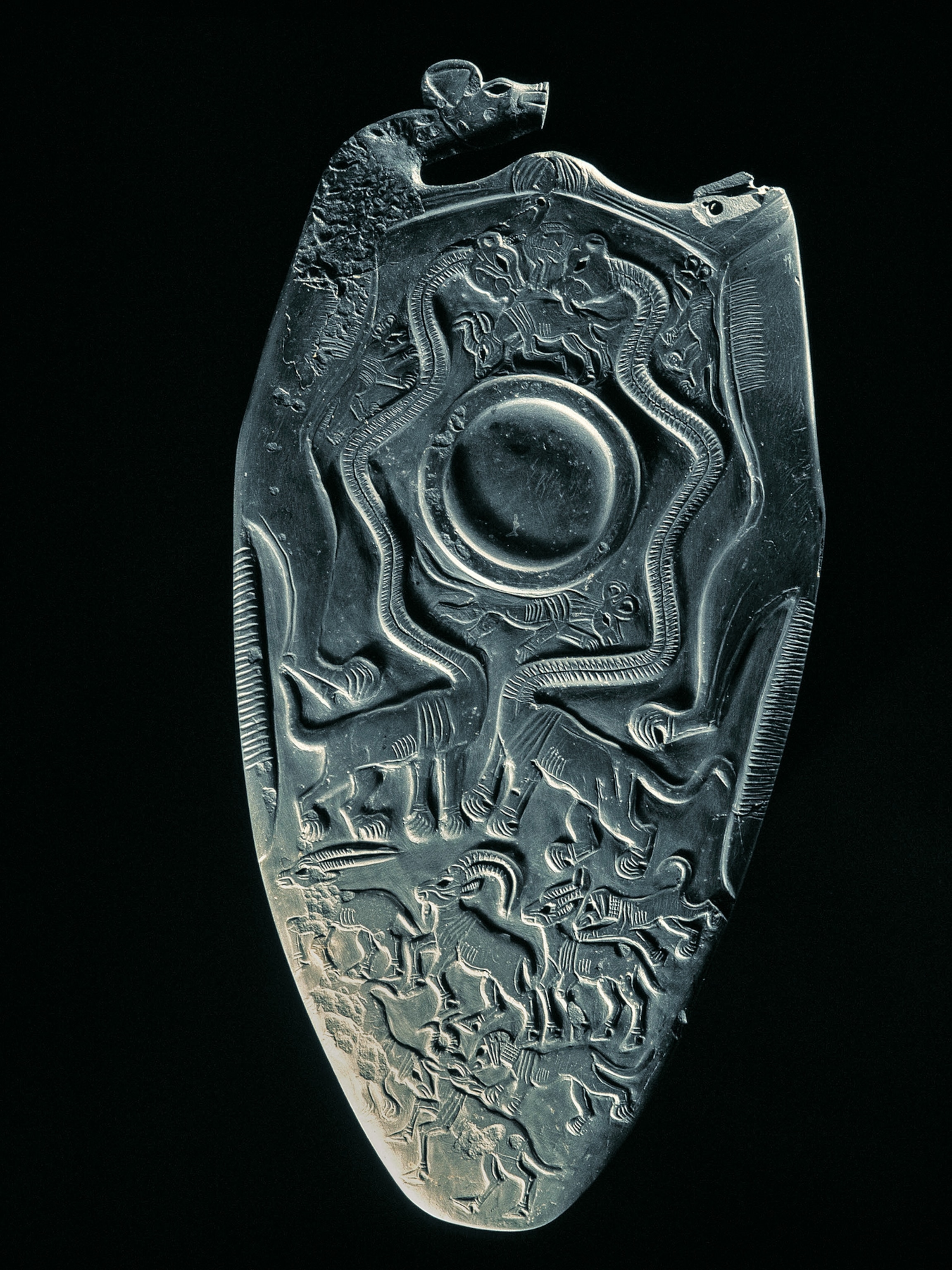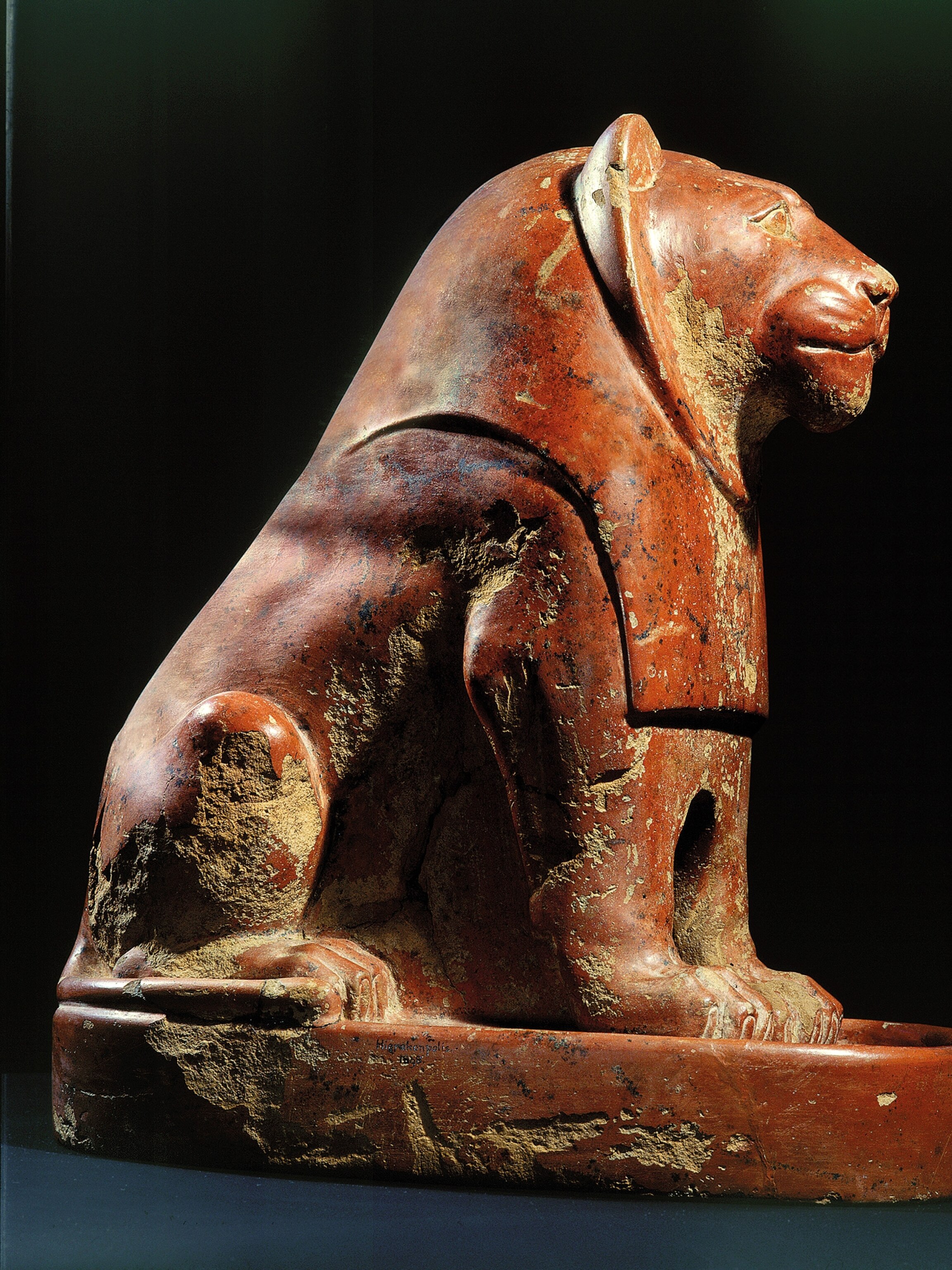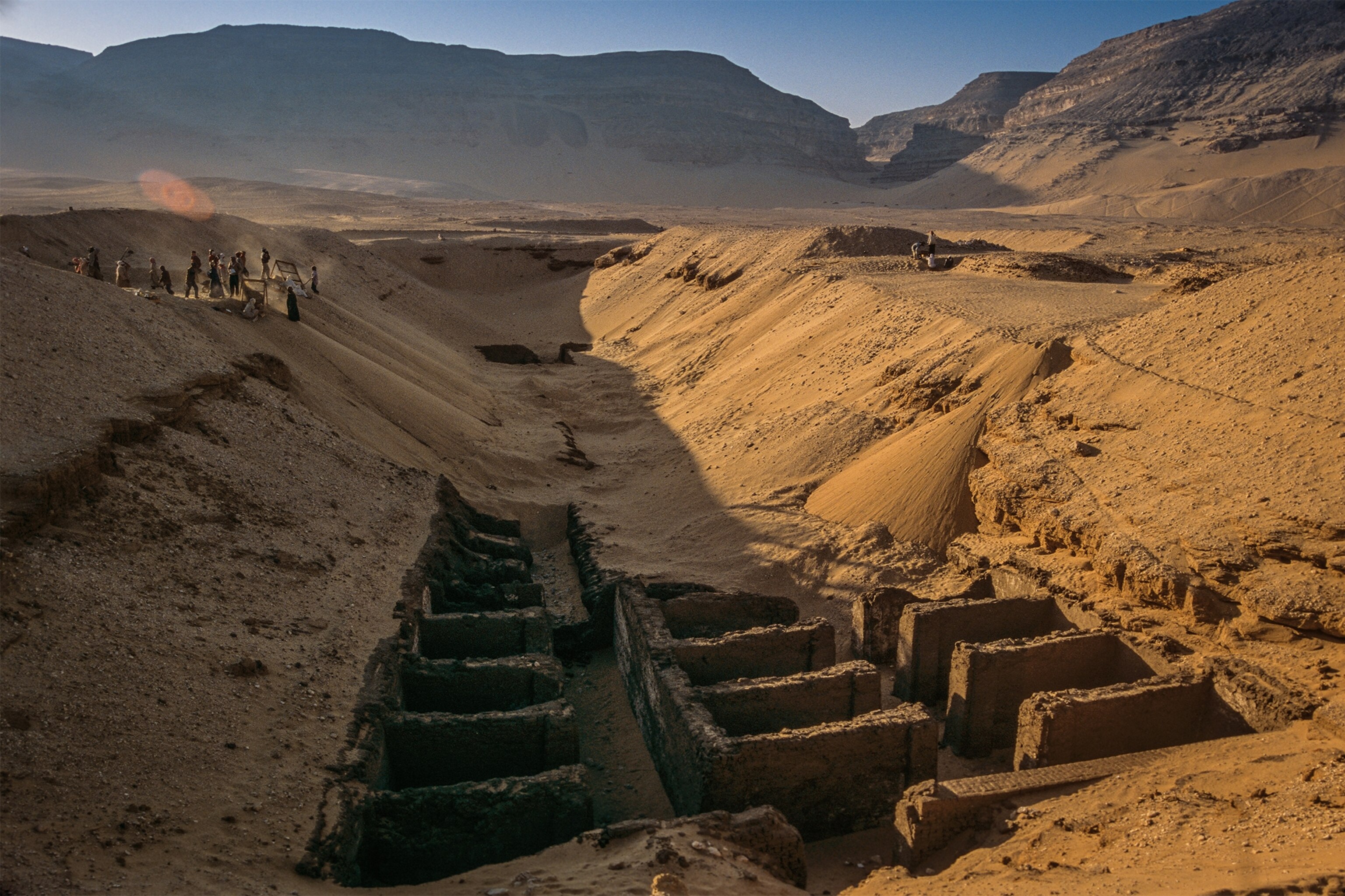
Who was Egypt's first pharaoh?
Five thousand years ago in North Africa, an ambitious king, known today as Narmer, unified two lands into the world's first great territorial state—Egypt.
Five thousand years ago, there was no single nation of Egypt—at least not as it exists today. There were, and had been for thousands of years, two lands: Upper Egypt in the south and Lower Egypt in the north. There are millennia-old inscriptions on ceramics and depictions of leaders from each kingdom that show two distinct entities with different sets of traditions.
Prior to unification, depictions of kings showed different regalia. Rulers of Upper Egypt wore a tall white crown called a hedjet, while in Lower Egypt kings donned a short red crown called a deshret. Around 3100 B.C., a king of Upper Egypt, known as Narmer, changed all that. By incorporating the lands west of the fertile, triangular Nile Delta region into his own kingdom—which spanned the lush Nile Valley area in the south (roughly from what is Cairo today to Lake Nasser)—he created a united Egypt, the world’s first great territorial state.
When the two lands united, it marked not only the beginnings of a political state, but also the origins of a great cultural one. Beginning with Narmer, Egypt began developing its own distinctive visual style, one that would echo through the ages as the iconography and symbols embraced by Narmer and his successors took hold. These symbols became tools used by pharaohs—from Khufu to Hatshepsut to Ptolemy XII—to convey power, strength, and unity for millennia.
(The catfish was sacred to Narmer and Egypt's first pharaohs.)
Kings and crowns
Works of art are remarkable in their ability to preserve moments in time, as the events of the day make an impact on the people who endured them. Records from Narmer’s time are rare, but one object that survived through the ages provides a window into the changes that took place during Narmer’s reign. It is a stone palette, similar to ones commissioned by various kings of Upper Egypt at the end of the Predynastic Period. Made from gray siltstone and sculpted with images of gods, beasts, and kings, these tablets were used to grind and mix cosmetic pigments. Some were designed for practical use, while others were ceremonial, and others were deposited in temples as votive offerings.
Narmer commissioned such a votive siltstone palette. British archaeologists James Quibell and Frederick Green discovered it in the ruins of a temple in Hierakonpolis (Nekhen), south of Luxor, in 1897-98. Now popularly known as the Narmer Palette, the shield-shaped object dates to circa 3200-3000 B.C., and it appears the ruler consecrated the palette to the temple of the falcon-headed god Horus, symbol of cosmic and political power. Unlike the mask of Tutankhamun, which has traveled the world, the Narmer Palette has never left Egypt. Today the 25-inch-tall artifact (which features some of the world’s earliest hieroglyphics) can be seen in the Egyptian Museum in Cairo.


The Narmer Palette was made from a single piece of siltstone and carved on both sides. Both the front and back feature depictions of the king. It is the earliest monumental representation of a pharaoh found to date. On one side, Narmer wears a hedjet of Upper Egypt, grasps an enemy by the hair, and raises a mace to strike. On the other side, the ruler sports a deshret from Lower Egypt as he surveys his fallen foes. It is the first time that an Egyptian king is depicted wearing each crown on the same work of art.
Egyptologists see the appearance of both crowns as evidence of Narmer’s creation of a unified Egypt under his rule and as active promotion of the feat. The pharaohs who followed would build on Narmer’s use of royal iconography and change it. The crowns of the two lands would eventually be combined into one, called a pschent (also referred to as a sekhmety).

This double crown visually united the lands upon the head that ruled them. The falcon-headed god Horus is often depicted wearing a pschent; Pharaoh Den, who ruled circa 2900 B.C., is currently believed to be the first depicted wearing the double crown, thus completing the metamorphosis—two lands into one—begun by Narmer generations before him.
It may seem counterintuitive, but the concept of two lands did not disappear with this 1st dynasty or any of the others that followed. Rather, the dual nature of the Egyptian kingdom was emphasized, as duality was an important tenet of Egyptian culture, including the throne itself. Later 1st dynasty pharaohs would embrace the title “Ruler of the Two Lands,” and following pharaohs would continue to use the title through the ages.
Keeping the identities of the two lands distinct from each other was a way of giving the new political order a divine sanction. Central to ancient Egyptian belief were two opposite and necessary forces—ma’at (order) and isfet (chaos), the static and dynamic forces that govern the universe. Balance was desired, and order and chaos must coexist in order for equilibrium to be achieved.
(Ancient Egyptian justice flowed from the gods to the pharaohs.)
Weapons of a pharaoh

Power poses
The palette also reveals the evolution of Egyptian visual style. Prior to Narmer, influences from outside Egypt made their way into works of art. Some seem merely decorative, like the rosette (an Elamite motif) used to identify the king’s sandal bearer, who stands just to his left on the front of the palette. On the reverse, two serpopards—mythical felines with long serpentine necks—form a circular compartment with their intertwined necks; these creatures are also found in ancient Elamite art.



Other Mesopotamian influences were the depiction of leaders as actual beasts— fearsome creatures like lions, bulls, hawks, or scorpions that destroy cities and crush enemies. Narmer is clearly shown twice on the palette in human form, and some scholars believe he shows up twice as a beast-king; on the front, he may be the falcon whose human arms perch above an enemy’s head, while on the reverse, in the lowest section of the chevron, he may be a bull charging through city walls and trampling a helpless foe. This beast-king iconography largely disappears after Narmer’s reign, although some vestiges of it remained. Pharaohs might be shown in human form but wearing a bull’s tail (such as Den, the fourth pharaoh to rule after Narmer).

The smiting tableau on the front of the Narmer Palette stood the test of time in Egyptian art. The positioning of Narmer’s body— with one upraised hand holding a mace while the other clutches a helpless enemy—can be found in almost every era of pharaonic Egypt. On the walls of his temple at Abu Simbel, Ramses II strikes down his enemies in Narmeric fashion, while more than a thousand years later, Ptolemy XII is depicted on the Temple of Horus at Edfu in the same exact pose.
What’s in a name?

Narmer’s name is written on the palette on both sides: a combination of the symbols for a catfish (nar) and a chisel (mer) appear at the top. Early Egyptologists, however, were not convinced that he was definitively the first pharaoh. Royal records from Narmer’s era are scarce, and many of the existing ones are incomplete. While there are several “kings lists” that record the names of pharaohs and their successors, intact ones that extend all the way back to that Early Dynastic era are few.
Two of the most important were found in the 1980s by researchers from the German Archaeological Institute in Cairo. They uncovered two cylinder seal impressions in the tomb of the pharaoh Den. These seals—still the oldest documented king lists to date—list rulers and successors of the 1st dynasty. One seal dates to the middle of the 1st dynasty and names six rulers. The other seal dates closer to the end of the 1st dynasty and names eight leaders. Both lists begin with Narmer.
Royal lists created millennia later, during the New Kingdom, have created the confusion. One of the most complete is the Abydos King List, engraved upon the wall of the mortuary temple of Seti I (13th century B.C.). Engraved on the wall, Seti and his heir, Ramses (the future Ramses II), face rows of cartouches bearing the names of Egypt’s past pharaohs. On this list, however, the first king listed is Menes, not Narmer.

The Turin Papyrus is another king list from the same era as Seti I. Rather than being engraved in stone, it is cursive hieratic script written on papyrus and is one of the most accurate and complete king lists, covering the 1st through the 19th dynasties. It, too, names the first king as Menes and not Narmer. Writing centuries later, classical authors, such as the fifth-century B.C. Greek historian Herodotus, wrote of Menes rather than Narmer as the unifier of Egypt. A third-century B.C. priest in the temple at Heliopolis, Manetho, was an author of another trusted source that also lists Menes as the first king.
Egyptologists tried to reconcile the use of these two names. Perhaps they were two different people, one who unified Egypt and another who ruled after him. Or Menes could have been a composite figure, cobbled together from the lives and deeds of other early kings. English Egyptologist Flinders Petrie came up with the most widely accepted theory: Narmer and Menes were the same person. Narmer was the name of the first pharaoh of the 1st dynasty, and Menes was an honorific title, meaning “he who endures.”
Important identification

Life and death
Exact details about Narmer’s life remain difficult to pin down. It is believed that he hailed from Hierakonpolis. He is credited with organizing his new unified kingdom into some 40 regions, called nomes. He married, and his royal wife’s name was Neithhotep, after a creator goddess, Neith. Narmer also built a temple dedicated to the creator god Ptah at Memphis, another important ancient Egyptian city.

Details of Narmer’s death are hazy; classical historians, writing millennia after he died, attributed it to being carried off by a hippopotamus. Some Egyptologists post that it could have been a figure of speech and not a literal hippo, but the cause of death remains an open question. Narmer chose to locate his tomb in the south and would be interred at what would become known as the Abydos Royal Cemetery, where his ancestors and his descendants would also be buried.
Narmer’s tomb is small, comprising two underground chambers that follow a Predynastic tradition of funerary architecture—a style that would end with him. Both Narmer’s widow and his son (Hor-Aha) would be buried in larger tombs. The pharaohs who followed would be buried in increasingly monumental structures— a tradition that reached its pinnacle in the grandiose pyramids erected by the pharaohs of the Old Kingdom.

Related Topics
You May Also Like
Go Further
Animals
- Fireflies are nature’s light show at this West Virginia state parkFireflies are nature’s light show at this West Virginia state park
- These are the weird reasons octopuses change shape and colorThese are the weird reasons octopuses change shape and color
- Why young scientists want you to care about 'scary' speciesWhy young scientists want you to care about 'scary' species
- What rising temperatures in the Gulf of Maine mean for wildlifeWhat rising temperatures in the Gulf of Maine mean for wildlife
- He’s called ‘omacha,’ a dolphin that transforms into a man. Why?He’s called ‘omacha,’ a dolphin that transforms into a man. Why?
Environment
- What rising temperatures in the Gulf of Maine mean for wildlifeWhat rising temperatures in the Gulf of Maine mean for wildlife
- He’s called ‘omacha,’ a dolphin that transforms into a man. Why?He’s called ‘omacha,’ a dolphin that transforms into a man. Why?
- The northernmost flower living at the top of the worldThe northernmost flower living at the top of the world
- This beautiful floating flower is wreaking havoc on NigeriaThis beautiful floating flower is wreaking havoc on Nigeria
- What the Aral Sea might teach us about life after disasterWhat the Aral Sea might teach us about life after disaster
History & Culture
- Scientists find evidence of ancient waterway beside Egypt’s pyramidsScientists find evidence of ancient waterway beside Egypt’s pyramids
- This thriving society vanished into thin air. What happened?This thriving society vanished into thin air. What happened?
Science
- Why pickleball is so good for your body and your mindWhy pickleball is so good for your body and your mind
- Extreme heat can be deadly – here’s how to know if you’re at riskExtreme heat can be deadly – here’s how to know if you’re at risk
- Why dopamine drives you to do hard things—even without a rewardWhy dopamine drives you to do hard things—even without a reward
- What will astronauts use to drive across the Moon?What will astronauts use to drive across the Moon?
- Oral contraceptives may help lower the risk of sports injuriesOral contraceptives may help lower the risk of sports injuries
- How stressed are you? Answer these 10 questions to find out.
- Science
How stressed are you? Answer these 10 questions to find out.
Travel
- A guide to Philadelphia, the US city stepping out of NYC's shadowA guide to Philadelphia, the US city stepping out of NYC's shadow
- How to make perfect pierogi, Poland's famous dumplingsHow to make perfect pierogi, Poland's famous dumplings
- The best long-distance Alpine hike you've never heard ofThe best long-distance Alpine hike you've never heard of
- Fireflies are nature’s light show at this West Virginia state parkFireflies are nature’s light show at this West Virginia state park
- How to explore the highlights of Italy's dazzling Lake ComoHow to explore the highlights of Italy's dazzling Lake Como
- Going on a cruise? Here’s how to stay healthy onboardGoing on a cruise? Here’s how to stay healthy onboard







